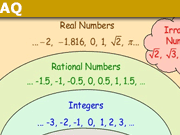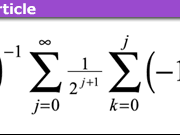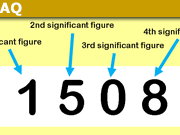Is There a Rigorous Proof Of 1 = 0.999…?
Yes.
First, we have not addressed what 0.999… actually means. So it’s best first to describe what on earth the notation [tex]b_0.b_1b_2b_3…[/tex] means. The way mathematicians define this thing is
[tex]b_0.b_1b_2b_3…=\sum_{n=0}^{+\infty}{\frac{b_n}{10^n}}[/tex]
So, in particular, we have that
[tex]0.999…=\sum_{n=1}^{+\infty}{\frac{9}{10^n}}[/tex]
But all of this doesn’t really make any sense until we define what the right-hand side means. There is an infinite sum there, but what does that mean? Well, we put
[tex]S_k=\sum_{n=1}^{k}{\frac{9}{10^n}} \ ,[/tex]
then we have a finite sum. So, for example
[tex]S_1=0.9, \ ~S_2=0.99, \ ~S_3=0.999, \ etc.[/tex]
So, in some way, we want to take the limit of this sequence.
Let’s consider a particularly simple sequence to illustrate the idea behind the definition of a limit of a sequence: 1/2, 1/3, 1/4,… The terms in this sequence get smaller and smaller. You might think that it’s obvious that it goes to 0, or that it’s obvious that a smart mathematician can prove that it goes to 0, but it’s not. It’s impossible to even attempt a proof until we have defined what it means for something to go to 0. So we have to define what the statement “1/2, 1/3, 1/4,… goes to 0” means before we can attempt to prove that it’s true.
This is the standard definition: “1/n goes to 0” means that “for every positive real number [itex]\epsilon[/itex], there’s a positive integer N, such that for all integers n such that [itex]n\geq N[/itex], we have [itex]|1/n| < \epsilon[/itex]”. With this definition in place, it’s quite easy to prove that “1/n goes to 0” is a true statement. What I want you to see here, is that we chose this definition to make sure that this statement would be true. The first mathematicians who thought about how to define the limit of a sequence might have briefly considered definitions that make the statement “1/n goes to 0” false, but they would have dismissed those definitions as irrelevant because they fail to capture the idea of a limit that they already understood on an intuitive level.
So the real reason why 1/n goes to 0 is that we wanted it to! Similar comments hold for the sequence of partial sums that define 0.999… It goes to 1, because we have defined the concepts “0.999….”, “sum of infinitely many terms”, and “limit of a sequence” in ways that make 0.999…=1. Can we define number systems such that 1=0.999… does not hold? Of course! But these number systems are not as useful, because they don’t conform to our intuition about limits and numbers.
Now that we know what a limit and an infinite sum is, let me give a fully rigorous proof to the equality 1=0.999… This proof is due to Euler and it appears in the 1770’s edition of “Elements of algebra”.
We know that
[tex]0.999…=\sum_{n=1}^{+\infty}{ \frac{9}{10^n} } = \frac{9}{10} + \frac{9}{10^2} + \frac{9}{10^3} +…[/tex]
This sum is a special kind of sum, namely, it’s a geometric sum. For (infinite) geometric sums, we can find its limit easily:
Let
[tex]x=\frac{1}{10}+\frac{1}{10^2}+\frac{1}{10^3}+…[/tex]
Then
[tex]9x=0.999…[/tex]
But, we also have [itex]10x=1+\frac{1}{10}+\frac{1}{10^2}+…[/itex], so [itex]10x-x=1[/itex].
This implies that [itex]x=\frac{1}{9}[/itex].
Hence,
[tex]0.999…=9x=1[/tex]
Does this proof look familiar? It should! It is essentially the same as Proof #2 in the previous post. The only difference is that every step is now justified by operations with limits.
See this supportive article: https://www.physicsforums.com/insights/why-do-people-say-that-1-and-999-are-equal/
The following forum members have contributed to this FAQ:
AlephZero
Fredrik
micromass
tiny-tim
vela
Advanced education and experience with mathematics








It should be unanimous that 1 – 0.9(9) = 0.0(0) = 0. Assume the opposite, then 0.0(0) != 0, contradiction.
Too much java, my TeX is rusty :D
[QUOTE=”alva, post: 5215165, member: 497526″]
But my reasoning is similar to the OP. He is taking more addends in one series than in the other.[/QUOTE]
[QUOTE=”weirdoguy, post: 5215170, member: 464738″]No it’s not, because he’s using infinite series, and you are using finite series. It is a big difference.[/QUOTE]
In addition, [USER=497526]@alva[/USER], you don’t seem to realize that 0.99 and 0.99… mean completely different things. The first number has two decimal digits that are shown explicitly, and an implied infinite number of zeroes that follow it. The second number has an infinite number of 9’s following the decimal point.
We are NOT saying that 1 = 0.99. We ARE saying that 1 = 0.99…, and the proof is given in the OP.
Also, 0.99… and 0.999… are exactly the same, while 0.99 and 0.999 are different.
[QUOTE=”alva, post: 5215165, member: 497526″]
But my reasoning is similar to the OP. He is taking more addends in one series than in the other.[/QUOTE]
No, in both cases, the number of addends is infinite. The only difference is that the series in the OP is convergent, while yours are divergent.
[QUOTE=”HomogenousCow, post: 5215156, member: 435628″]Here you’ve just made some bizarre arguments and obvious arithmetic mistakes.[/QUOTE]
Please, let me know what are “my arithmetic mistakes”.
No it’s not, because he’s using infinite series, and you are using finite series. It is a big difference.
[QUOTE=”HomogenousCow, post: 5215152, member: 435628″]You can’t manipulate divergent series that way, also you forgot the negative signs at the end.[/QUOTE]
You’re right and I apologize for the mistake in the signs.
Moreover where I said “my age” I meant “my age from Jesus’s birth.
But my reasoning is similar to the OP. He is taking more addends in one series than in the other.
[QUOTE=”alva, post: 5215133, member: 497526″]and never 0.99999… = 1[/QUOTE]
Your “proof” is just plain wrong. Just deal with the fact that 0,(9)=1.
[QUOTE=”alva, post: 5215133, member: 497526″]Let x= 1/10 +1/100 + …
Lets take just 2 addends, x=0.11
Then 9x = 0.99
But, we also have 10x = 1 + 1/10 = 1.1, so 10x – x =0.11
Hence 0.99 = 9x = 0.99
You can use 3 addends and get 0.999 = 9x = 0,999
And 4 addends and 5, and calculate the limit when n -> infinite and never 0.99999… = 1[/QUOTE]
Here you’ve just made some bizarre arguments and obvious arithmetic mistakes.
[QUOTE=”alva, post: 5215141, member: 497526″]I was born in 1950 and my brother in 1952.
In many years my age will be 1950 + 1 + 1 +1 +1 ….
In many years my brothers age will be 1952 +1 + 1 +1 ….
So the difference will be 1952 +( 1 + 1 +1+ …) – 1950 – ( 1 +1 +1+1+…) = 1952 + (1 +1 +1 +…) – 1950 +2 + (1 +1 +1..) = 0[/QUOTE]
You can’t manipulate divergent series that way, also you forgot the negative signs at the end.
I was born in 1950 and my brother in 1952.
In many years my age will be 1950 + 1 + 1 +1 +1 ….
In many years my brothers age will be 1952 +1 + 1 +1 ….
So the difference will be 1952 +( 1 + 1 +1+ …) – 1950 – ( 1 +1 +1+1+…) = 1952 + (1 +1 +1 +…) – 1950 +2 + (1 +1 +1..) = 0
Let x= 1/10 +1/100 + …
Lets take just 2 addends, x=0.11
Then 9x = 0.99
But, we also have 10x = 1 + 1/10 = 1.1, so 10x – x =0.11
Hence 0.99 = 9x = 0.99
You can use 3 addends and get 0.999 = 9x = 0,999
And 4 addends and 5, and calculate the limit when n -> infinite and never 0.99999… = 1
[QUOTE=”alva, post: 5215060, member: 497526″]Let
x=110+1102+1103+…
Then
9x=0.999…
But, we also have 10x=1+110+1102+…, so 10x−x=1.
This implies that x=19.
[/quote]None of the above makes any sense. In your definition of x, its value is at least 2300. How can 9x be 0.999…?
[QUOTE=alva]
Hence,
0.999…=9x=1
**********************************************************
Im sorry but Im trying to copy/paste the OP message but the format is not preserved
**********************************************************
Lets do the proof with n=2 for ALL the equations
Let x = 1/10 + 1/100 = 0.11
Then 9x = 0.99
But, we also have 10x = 1 + 1/10 = 1.1 so 10x-x =0.11
Hence
0.99 = 9x = 0.99 !!! yes
[/quote]Of course. If x = .11, then ordinary arithmetic can be used to show that 9x = .99. So what?
[QUOTE=alva]
And, as anyone can see, you can repeat the proof for n=3,4… and using limits, when n->infinite, the result is clear, 1 is not = 0.999999…[/QUOTE]
[QUOTE=”gill1109, post: 5214887, member: 401042″]Yes you are right. However the surreals do include numbers (lots and lots of them!) which are strictly between all of 0.99999…9 (any number of repetitions) and 1.[/QUOTE]
That depends how many repetitions of ##9## you take in ##0.999…##. If you take countably many, then sure. But if you index over all ordinals, then no.
[QUOTE=”micromass, post: 5214863, member: 205308″]Whether ##1=0.9999…## in the surreals depends highly on the definitions for ##0.9999…##. Some definitions make it equal, others don’t.[/QUOTE]
Yes you are right. However the surreals do include numbers (lots and lots of them!) which are strictly between all of 0.99999…9 (any number of repetitions) and 1.
[QUOTE=”gill1109, post: 5214572, member: 401042″]Here is a number system in which 1 is not equal to 0.9999…. and it moreover is rather useful in game theory, and some people even imagine it might be useful sometime in the future, in physics: J H Conway’s “surreal numbers”. [URL]https://en.wikipedia.org/wiki/Surreal_number[/URL][/QUOTE]
Whether ##1=0.9999…## in the surreals depends highly on the definitions for ##0.9999…##. Some definitions make it equal, others don’t.
[QUOTE=”micromass, post: 5214231, member: 205308″]micromass submitted a new PF Insights post
[URL=’https://www.physicsforums.com/insights/is-there-a-rigorous-proof-of-1-0-999/’]Is There a Rigorous Proof Of 1 = 0.999…?[/URL]
[IMG]https://www.physicsforums.com/insights/wp-content/uploads/2015/08/999-80×80.png[/IMG]
[URL=’https://www.physicsforums.com/insights/is-there-a-rigorous-proof-of-1-0-999/’]Continue reading the Original PF Insights Post.[/URL][/QUOTE]
I suggest 1 – 0.9999… = 0.0000….
Always find these fascinating, even if most of it goes over my head at this point.
the question which is obvious is….how far is 0.999… away from 1?…since the answer is very close to 0 as it never ends…therefore 0.999… tends to 1.
sir, nice way.
I have a nice childhood memory about this. My school teacher had not checked this, and had the nice idea to write, instead of an open interval [0,1) a closed interval [0.0.9999…]. I had heard somewhere that 1=0.999…, so I simply said this. The teacher, and the whole class, disagreed. So a discussion started, and I had to think about how to prove it. What I invented was that 1/9 = 0.1111…, 8/9 = 0.8888…, but when we add 0.1111… to 0.88888… we will clearly get 0.9999…. On the other side, 1/9+8/9 = 9/9 = 1.
The next day it became clear that I was right. Some guys have looked into some books.
The better proof is to compute 9*0.9999… = 10* 0.9999… – 0.9999… = 9.999999..-0.99999… = 9.
I think there is a problem with the step, where you take 10x-x =1.
Applying operations on infinite sums has been considered dangerous, as far as I know.
Here is the ‘silly’ proof. 0.999… = 0.333…+0.666… = 1/3 + 2/3 = 3/3 = 1
You have to be careful, because Cantor’s hierarchy of trans-finite numbers doesn’t exist in the Surreal Numbers. For example,one might be tempted to identify Conway’s $\omega = {0,1,2,…|}$ with Cantor’s $\aleph_0$, since they are both intuitively “the infinity of the integers”. But in Cantor’s system, $\aleph_0$ is the smallest (positive) infinite number, whereas in Conway’s there does not exist any such smallest infinity since we also have $\omega-1$, $\omega/2$, $\sqrt{\omega}$, etc. Conversely, in Cantor’s system there is no largest infinity, but in Conway’s there is (On).
I said:"I think there can be contradictions in mathematics"You said:"So you think 1+1=3 is valid and can be proven? Because that is equivalent to what you just said."I don't think I need to comment on this, it's so ridiculous that it speaks for itself.
I prefer to keep it in degrees throughout, and although you can subtract the 89, I won't. To explain it, it's another series of numbers that suggest something, but somewhat different from the other. It suggests that for any number like 89.99999, there's another number between it and 90, arrived at via x/(sine x). You can then add more 9s, and it still applies. However many 9s you add, this rule applies, so it seems very reasonable to say that it applies to 89.99999…….. as well. That means there's at least one number between 89.9999….. and 90.Now because as I mentioned, infinities can be compared, this seems to reveal the existence of an infinity greater than the first one, or at least, a number or set of numbers that goes numerically higher. Certainly worth thinking about, but as I said, I think there can be contradictions in mathematics, so it's not an attempt to disprove your proof of 0.9999…. = 1.
I do believe in mathematics, but I just take a different view of it than you do. Gödel's work meant that many others saw the edges of it, from the 1930s on, so my view isn't a controversial one.
I never said it wasn't useful! It's very useful. And it doesn't matter that it's a bit rough round the edges either.
Incidentally, and I'm not going to get into discussion about this, if one should show that there's always a number between 0.9999…. and 1, that might suggest that they're different. Well I can show that there's always a number in between 89.9999…… and 90. It's the expression x/(sine x) again, it always gives a number nearer 90, however many 9s there are.Now I should make my position clear – I'm not arguing that your proof of 0.9999…. = 1 is false. I think mathematics is not a consistent system, and that it gets a bit rough round the edges, that's all. Perhaps I've shown that a bit.
You seem to think we should define things first, and then do our exploring. But sometimes the exploring helps to inform the definitions, and this is how mathematics has actually developed. This means one can point out a mathematical structure without necessarily having a rigorous definition. But a definition I've given for the relevant number, whether a loose one, and whether or not it fits with your definitions, is an angle x between 0 and 90 degrees such that x/(sin x) = exactly 180/π.
By the way, I did say, but probably should have emphasised more, that what applies to one pair of numbers doesn't necessarily apply to the other. There are things that happen at or near 0 that don't happen elsewhere. But this is surely relevant, nonetheless! Thanks for the discussion.
I never said it was a proof, surely even you noticed that. I said it was relevant, and that the context can make a difference. The point that the context makes a difference is borne out by micromass above saying about the context of surreal numbers:"Whether 1=0.9999… in the surreals depends highly on the definitions for 0.9999… . Some definitions make it equal, others don't."So it's relevant to point out a sequence relating to the second pair of numbers I mentioned, in which there is a distinction between the two of them, because one infinite sequence lands somewhere different from the other.Incidentally, there have been distinctions drawn between different infinities, and it has turned out that they can be compared, and one infinity can turn out to be 'larger' than another. This might intuitively seem impossible, but ways to compare them were found. There is some loose similarity between that and what I've done.
That's what one would expect it to be. I've shown that the second pair isn't just 0 and 0.
Well, there's a symmetry to be pointed out. First, you have 0.9999….. and 1, and these two numbers look the same, or almost the same. People discuss whether they're the same, and whether there's a proof that they are.Then, if you subtract 0.9999….. from 1, you find another pair of numbers – that is, the result of the subtraction, and zero. This pair of numbers can be called 1 – 0.9999…. , and 0.And there's a symmetry between these two pairs of numbers. Each pair may well be in the same relationship, whatever that is. So anything shedding a bit of light on either pair might be relevant. And showing the second pair to be different from each other is relevant.
Yes I knew it was 1 radian."This is by definition, not up for debate". This implies that all our definitions are, by definition, correct.What you learned in primary school may or may not be true. But I have said that the context makes a difference sometimes.But the question of comparing a whole number, or a non-negative integer, and another nearby number that approaches it with an infinite series, is not always a clear cut question. And what I've set out has bearing on it, because I've show the two looking different, and looking existent.Don't forget that we learn as we go, the mathematical structures we have are not just a given eternal structure, they were put together bit by bit by finding things, and what we have is, as always, incomplete.
Sorry, our posts crossed. Yes, I know you think that whether or not a number exists is related to whether or not one can specify the positions of the digits. But the mathematical structure I've shown above hints at a relevant structure that is uncovered, and exists in some way other than just conforming to a made up set of rules.
Putting in 0.0001, I get x/(sin x) = 57.295779513111409697664737311509try putting in 0.0000001then 0.00000000000000001.the result will approach 180/[pi], and to me this shows something that is discovered, rather than invented, and has bearing on the similar questions we've been looking at.
" 0.999999… exists because every digit in the decimal representation can be specified. If you ask, "what digit is in the 12th place?" Answer: 9. If you ask, "what digit is in the 59th place?" Answer: 9. If you ask, "what digit is in the 623rd place?" Answer: 9. No matter what specific digit you ask about, the answer is always "9". "That's true, and you believe that it's significant.
See posts above. There's a series of increasingly small angles near zero degrees that approach a number at infinity, but that number is above zero. It's clear that this number gives x/(sin x) = 180/π, because the values approach that number. Whether or not any other values give 180/π makes no difference, but it's interesting to hear it.
Well, it's a matter of taste to some extent. You say you can prove that within a particular artificial system, a number 0.99999999…. exists, but 1 minus that number, or 0.00000….0001 doesn't exist. And yet I've shown that the second number can be expressed as an angle between zero and 90 degrees.This has bearing on the question of whether mathematics is invented or discovered. Are we inventing the rules, or discovering them. When I look at the points above about the digit 1 in my number, I think there's a bit too much inventing going on.
"????" ….see earlier posts
If you say that one number exists and another doesn't, you need to say what you mean by exists. If you mean exists within mathematics, Gödel showed that mathematics isn't necessarily a self-consistent system, so existing within mathematics isn't necessarily a meaningful concept.If you're not keen on how my number is expressed, perhaps you'd prefer it if I said:an angle θ such that θ/(sin θ) = exactly 180/π. I can prove that this angle is not zero, because θ = 0 gives a different result.
I don't know what you mean by existence, when you say you can prove the existence of your number. But it seems clear enough that if we can talk about numbers with an infinite number of decimal places that all make a difference, then my number and yours are very similar. And my number and yours add up to one, which gives them more common ground.About the position of the 1 in my number, out of all those 9s of yours, there must be one that corresponds to my 1. So whatever problems I have with my number (and God knows it's hard to keep them all in line), you must have the same problems with yours.
So you have a rule that 'each numerical digit must have it's concrete position'. I suppose you know the positions of all the 9s in 0.99999….. then. But even if you argued that their positions are more concrete than the 1 in the number I used, it's not clear where the rule came from.what I've shown is a series that converges on, or approaches, a number at infinity, and the point is, whatever the existence status of that number at infinity, it isn't zero. And surely whatever its existence status, it's similar to the existence status of the numbers you're talking about.
Well, that may be so, but this thread is a discussion on the basis that such numbers are worth talking about, so we're assuming they have some meaning before we start. If you say 'there is no such number', then presumably you think this whole thread is pointless.
I can show that whatever the meaning of the number 0.0000000 => 00001, with an infinite number of zeros, it is different from 0. This means that other similar numbers are probably the same, though it does depend on the context. The method involves showing that the two numbers 0.0000000 => 00001 and 0 give completely different output numbers when put into an equation.To show that 0.0000000 => 00001 does not equal 0.Take the equation θ/(sin θ) , where θ is an angle in degrees.For θ = 0.0000000 => 00001, it gives θ/(sin θ) = 180/π = 57.295779513082320876798154814105this is known because a series of increasingly small angles such as 0.0001, 0.0000000001, 0.0000000000000001 etc.give numbers that approach 180/π.But for θ = 0, it gives θ/(sin θ) = 0Therefore 0.0000000 => 00001 does not equal 0.Any thoughts would be appreciated, thanks.
Letx=110+1102+1103+…Then9x=0.999…But, we also have 10x=1+110+1102+…, so 10x−x=1.This implies that x=19.Hence,0.999…=9x=1
You can also use, though not as nice, the perspective of the Reals as a metric space, together with the Archimedean Principle: then d(x,y)=0 iff x=y. Let then ## x=1 , y=0.9999…. ##Then ##d(x,y)=|x-y| ## can be made indefinitely small ( by going farther along the string of 9's ), forcing ## |x-y|=0## , forcing ##x=y ##. More formally, for any ##\epsilon >0 ##, we can make ##|x-y|< \epsilon ##
Here is a number system in which 1 is not equal to 0.9999…. and it moreover is rather useful in game theory, and some people even imagine it might be useful sometime in the future, in physics: J H Conway's "surreal numbers". https://en.wikipedia.org/wiki/Surreal_number
Nice!The informal proof I always share with people is that 1/9=0.111…, 2/9=0.222…, 3/9=0.333…, and so on until 9/9=0.999…=1
Great insight, thanks Micro.